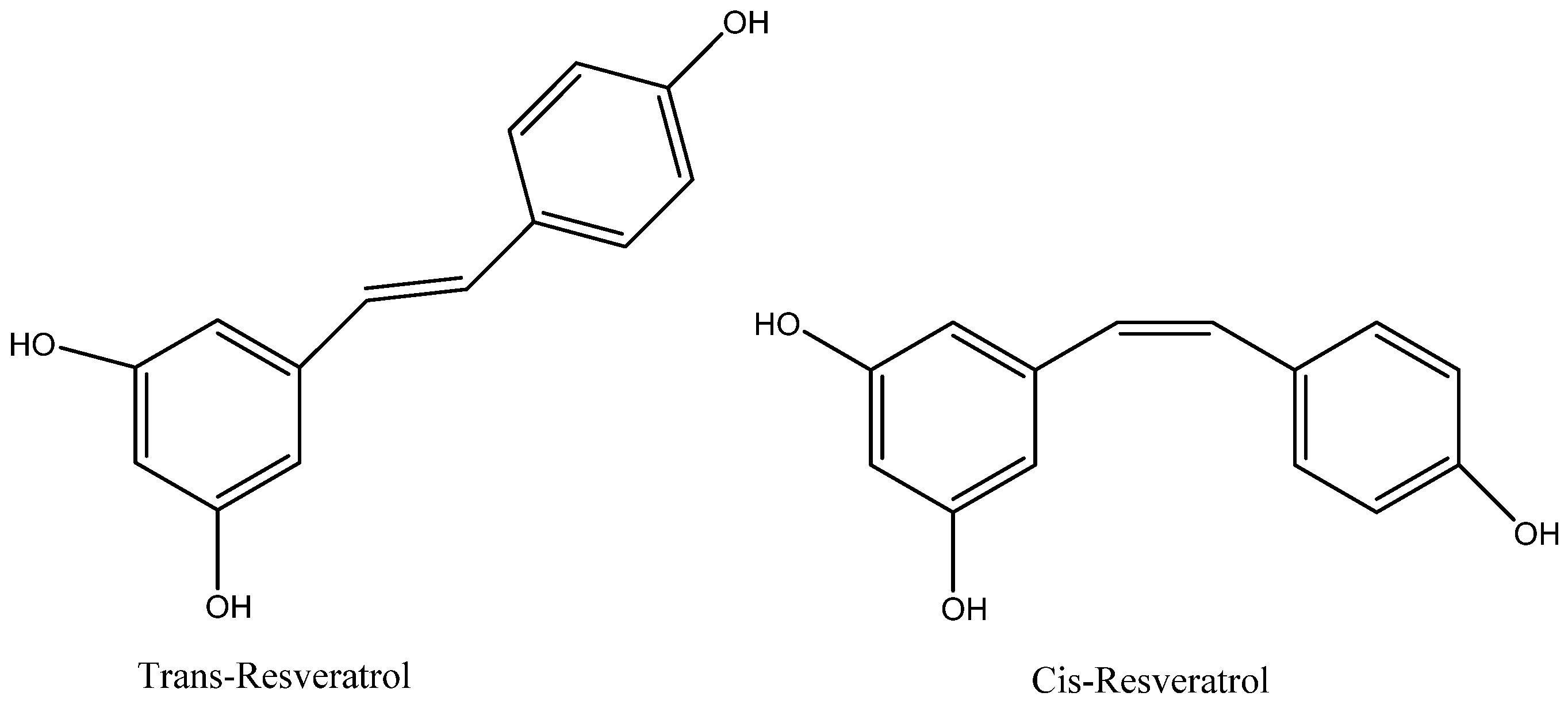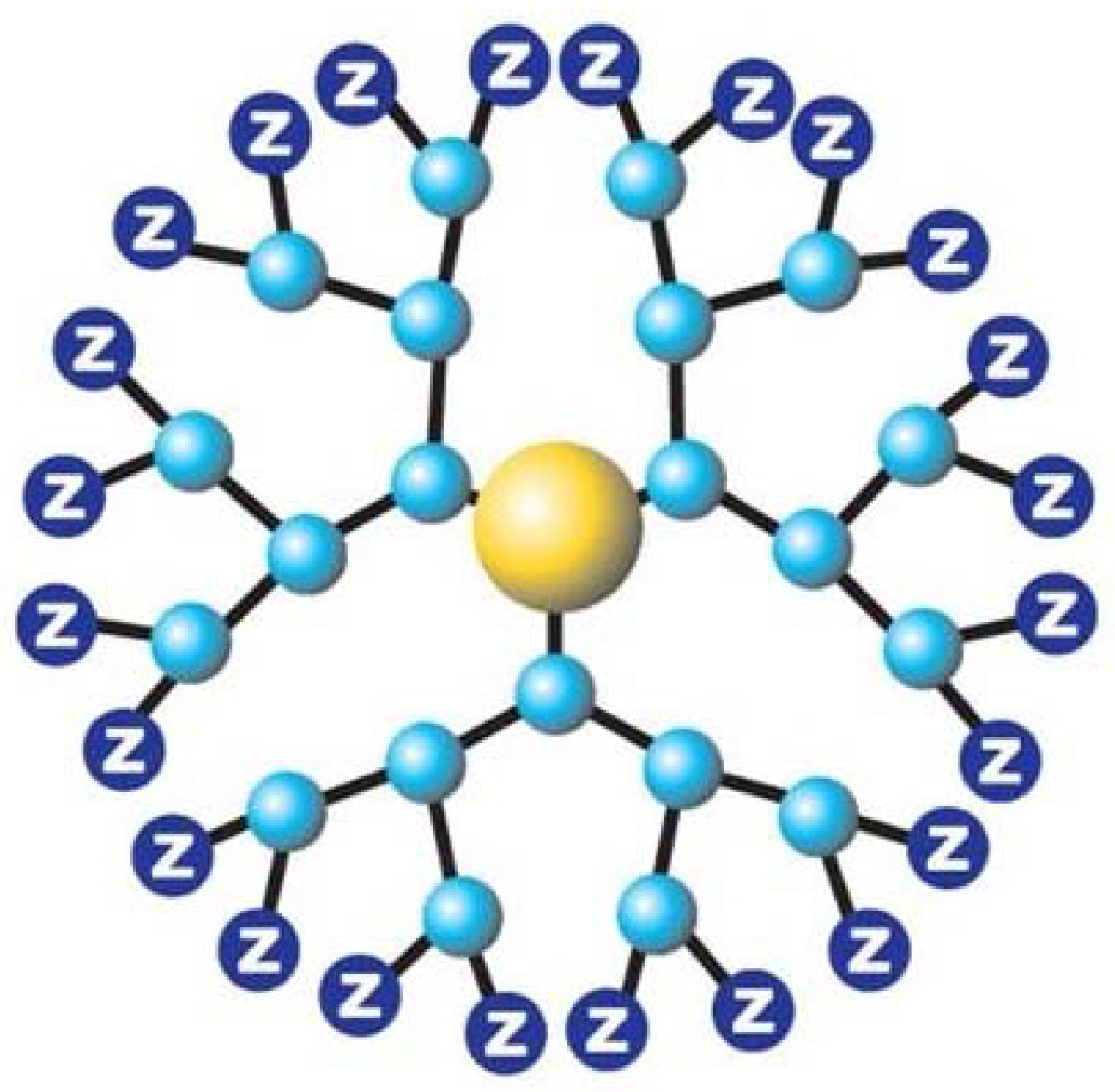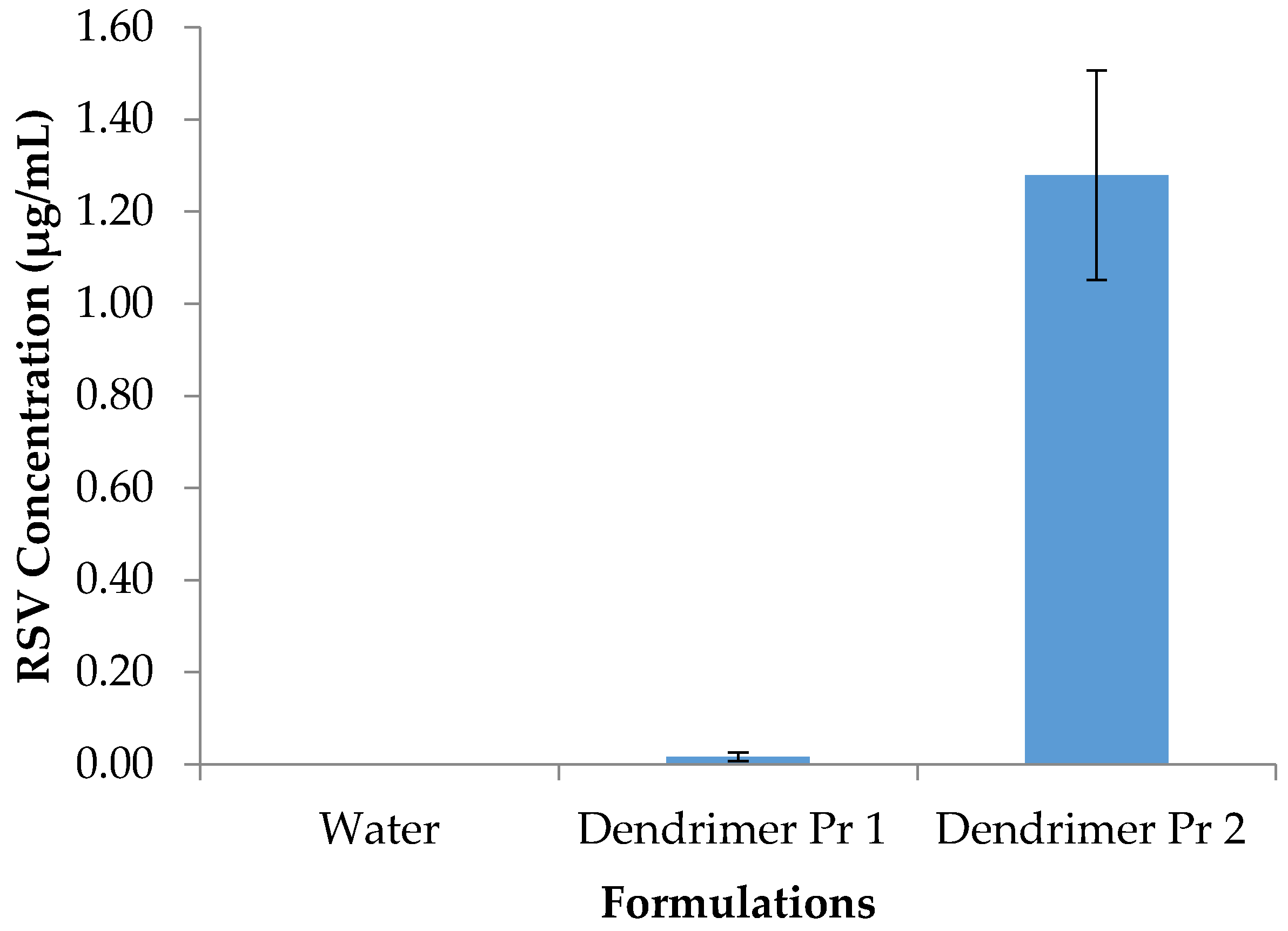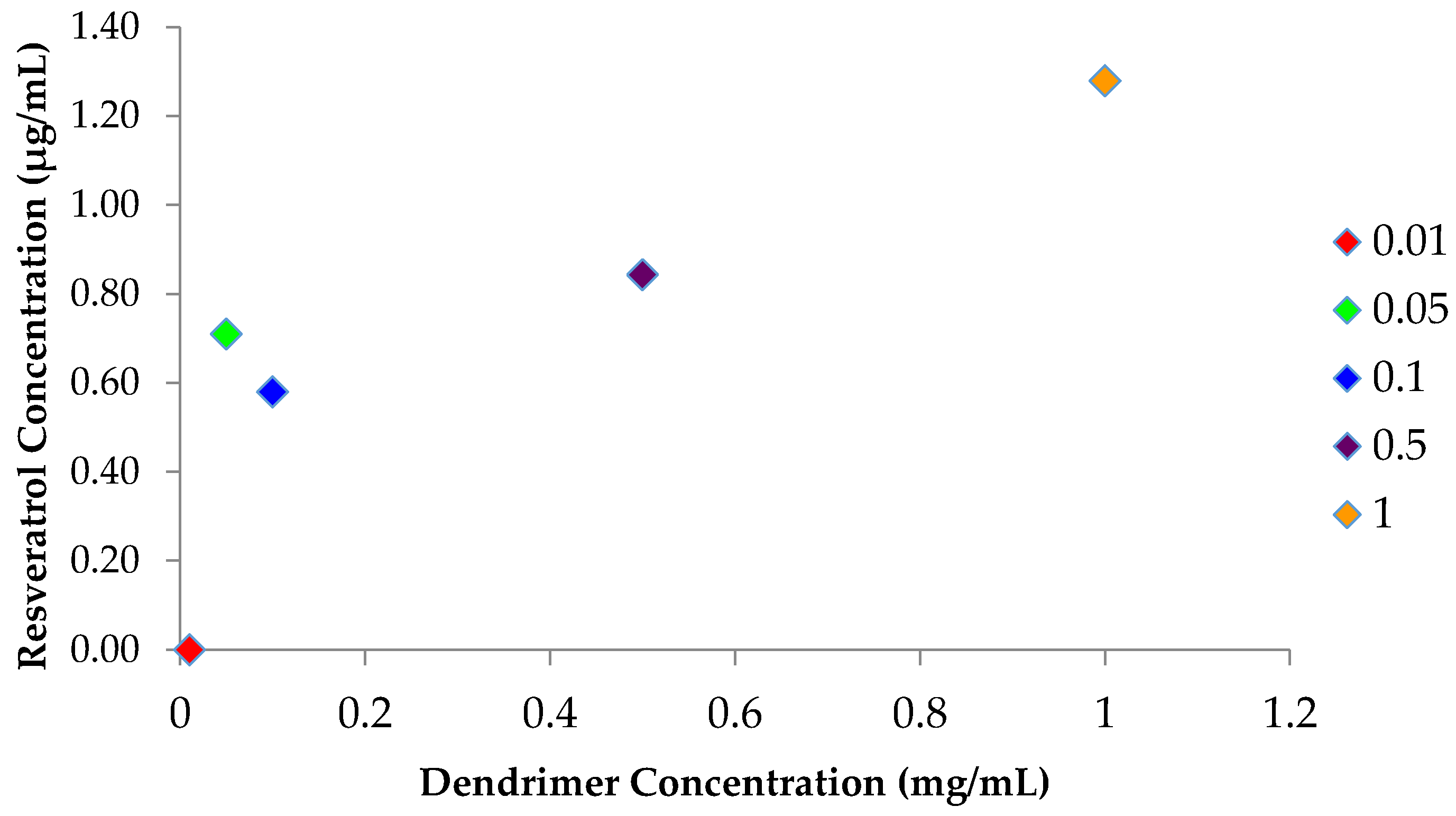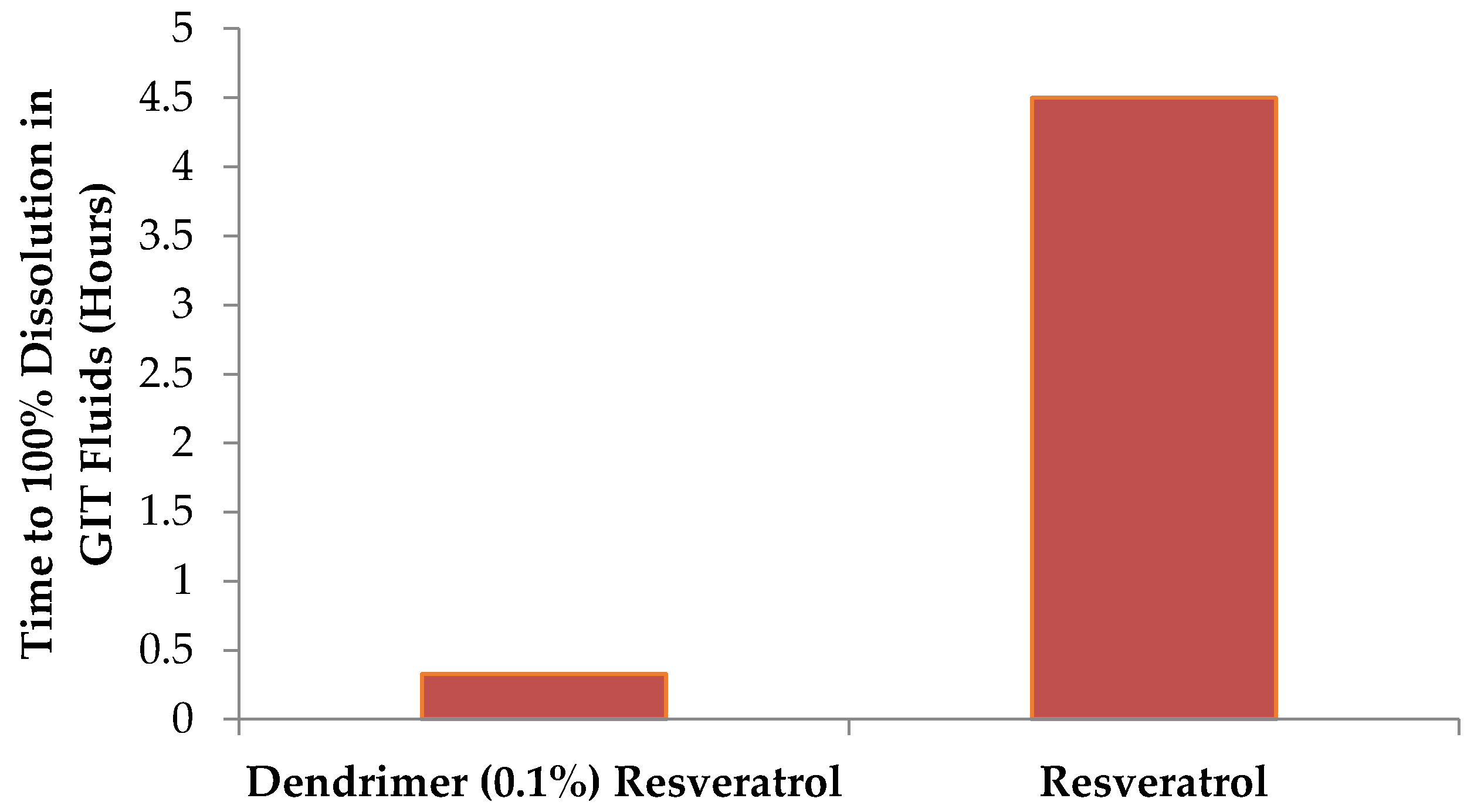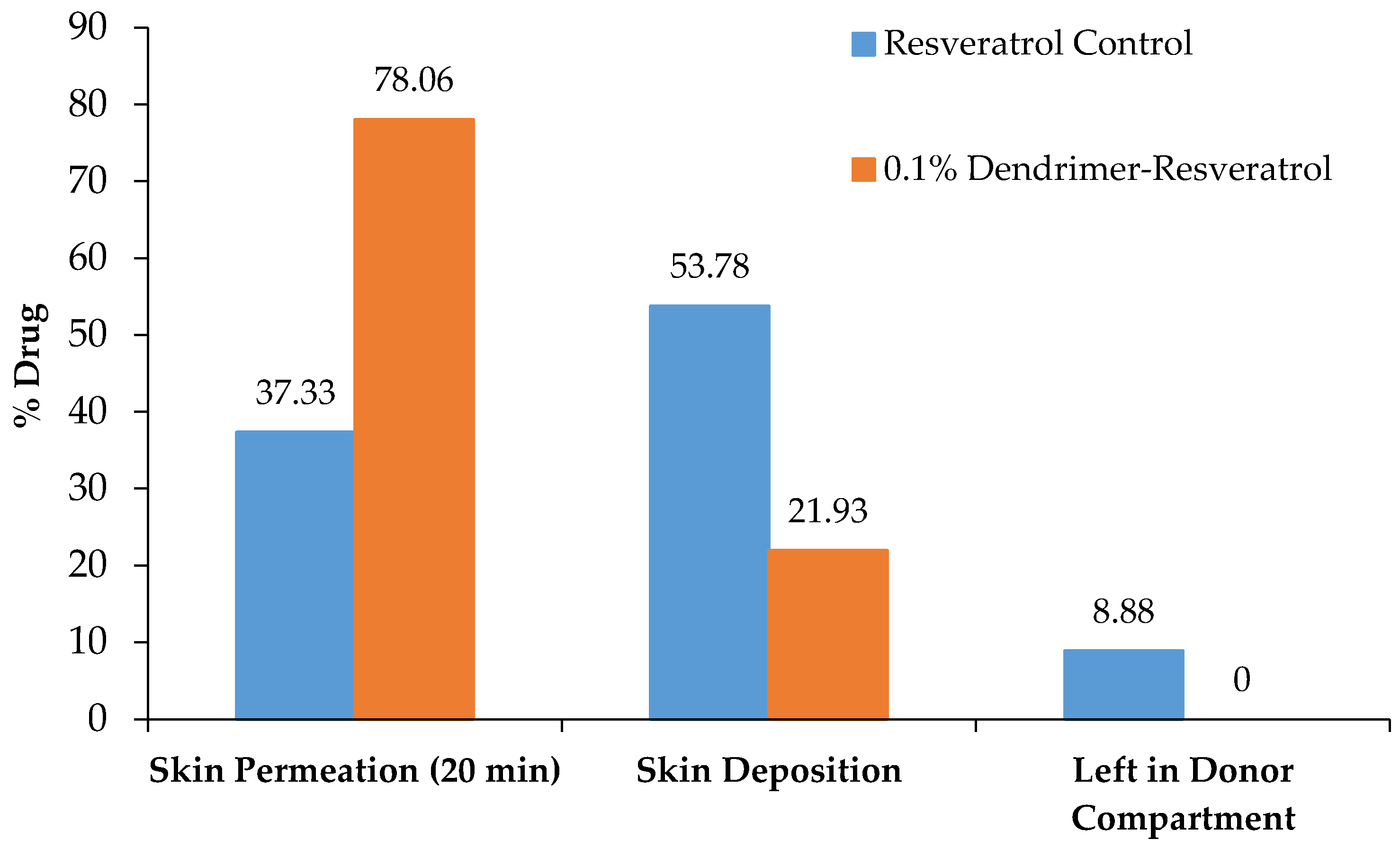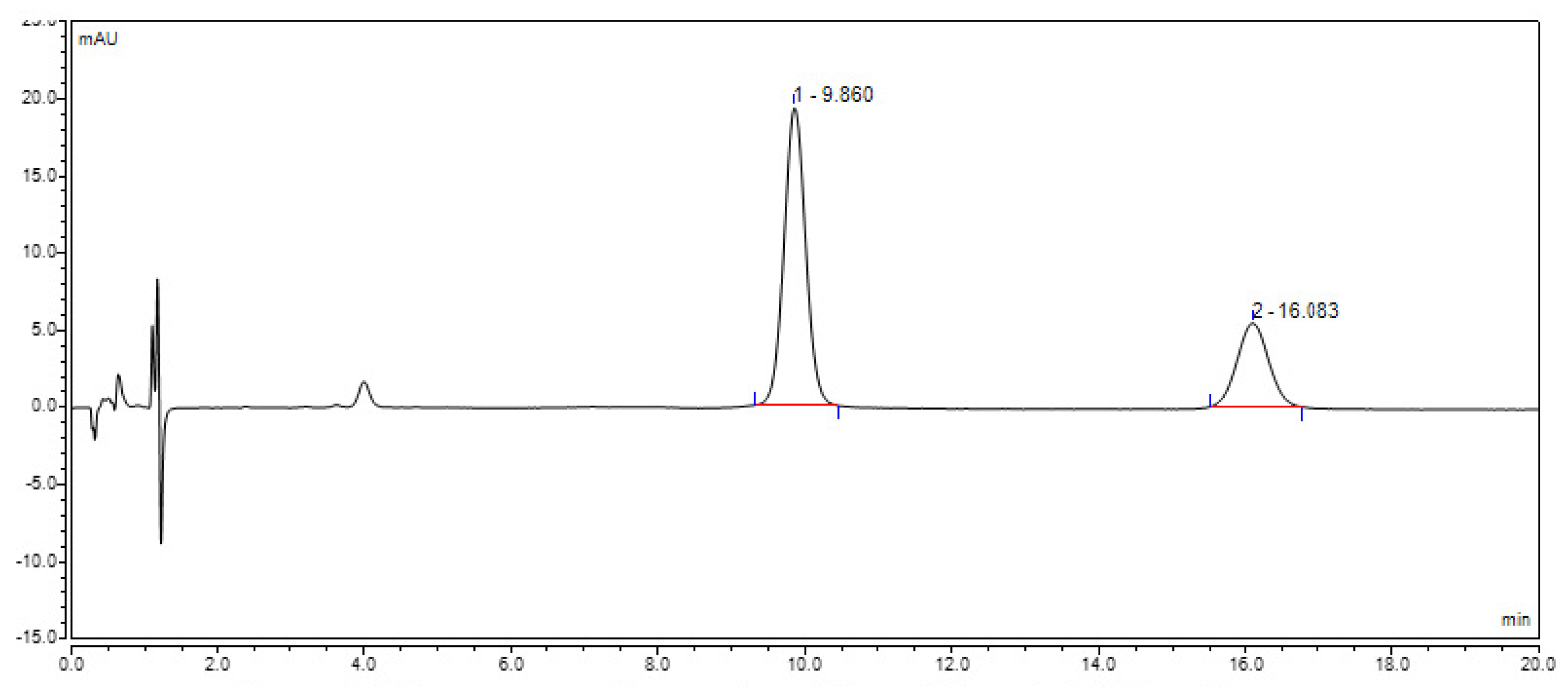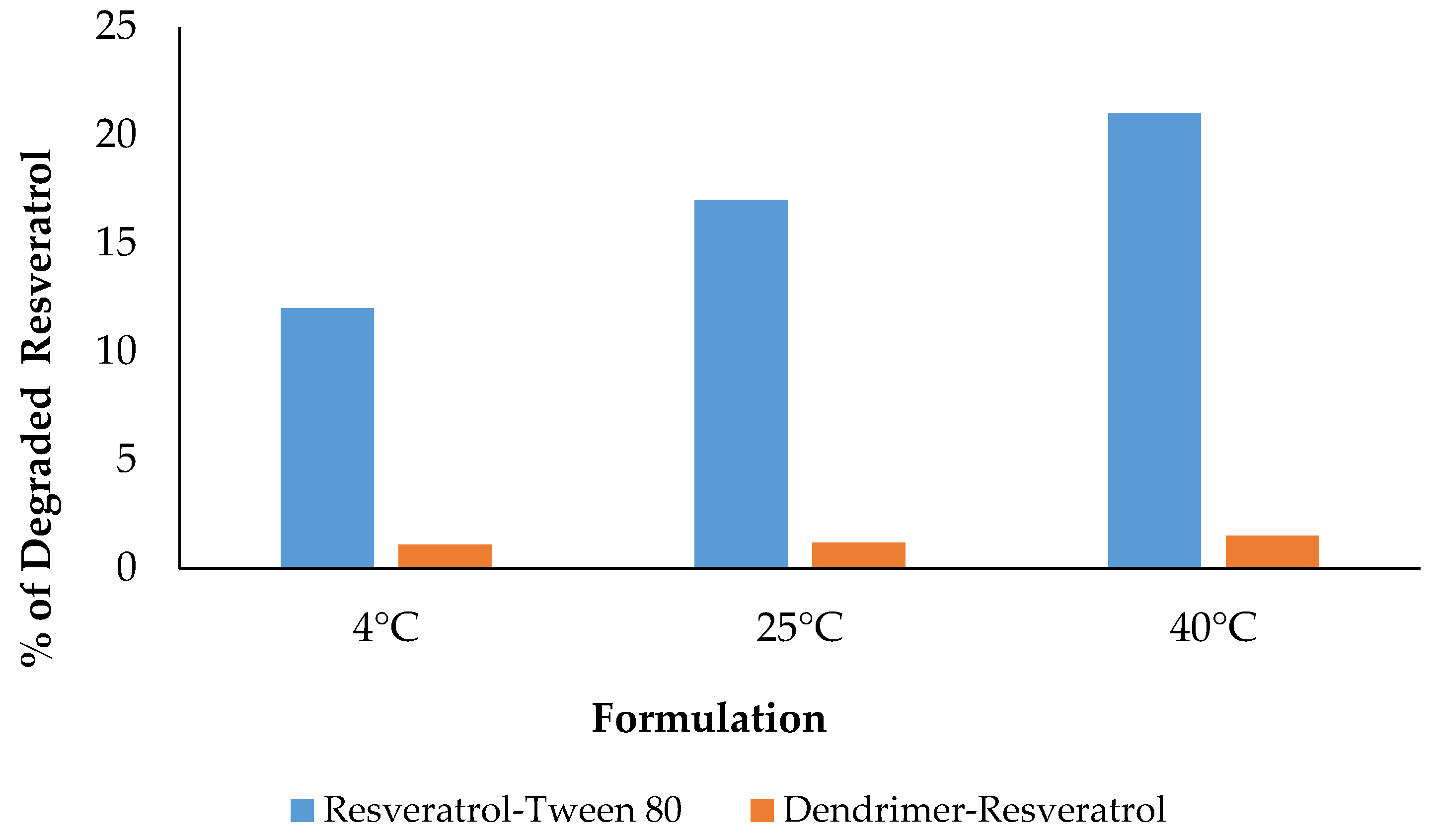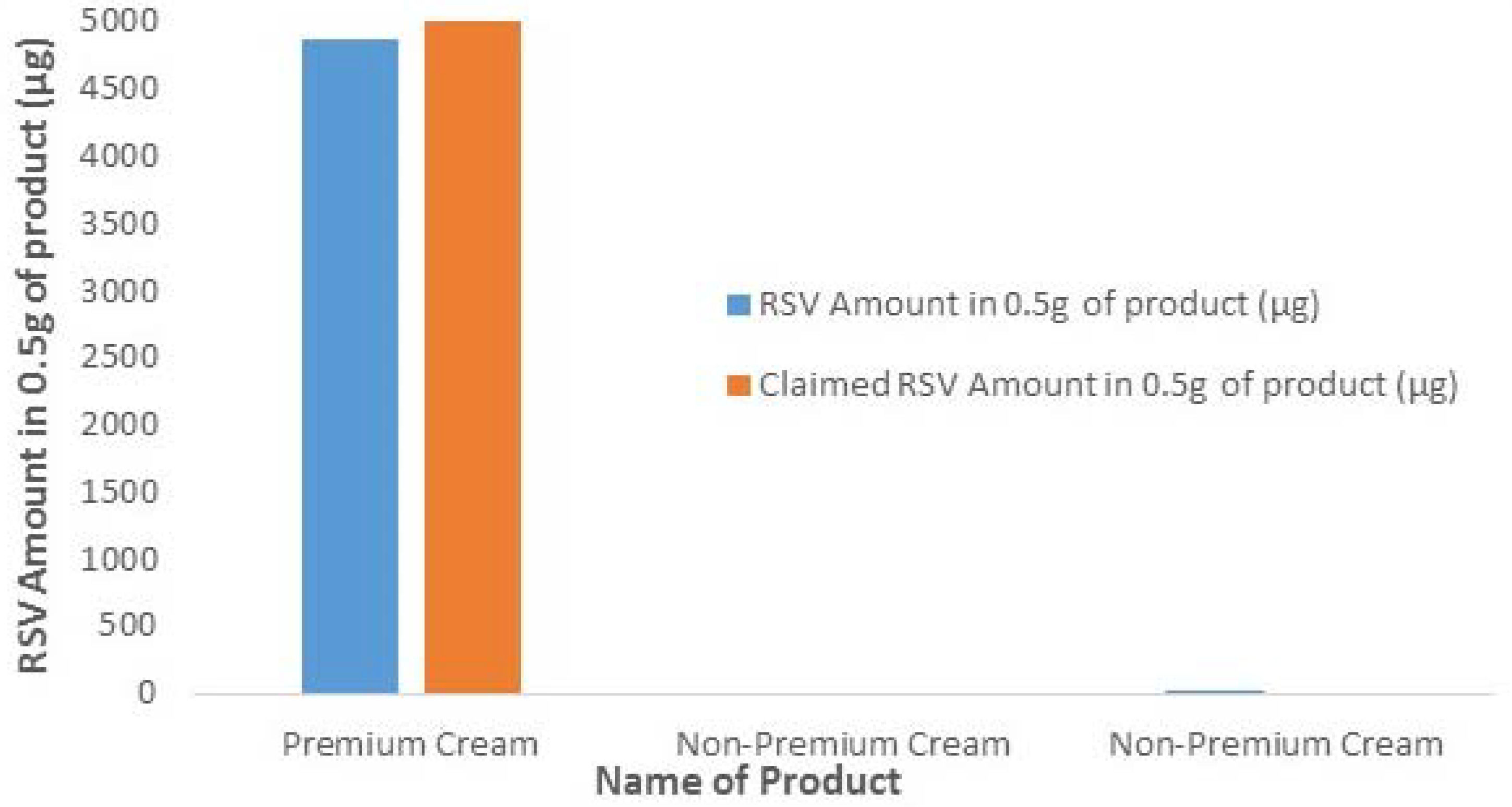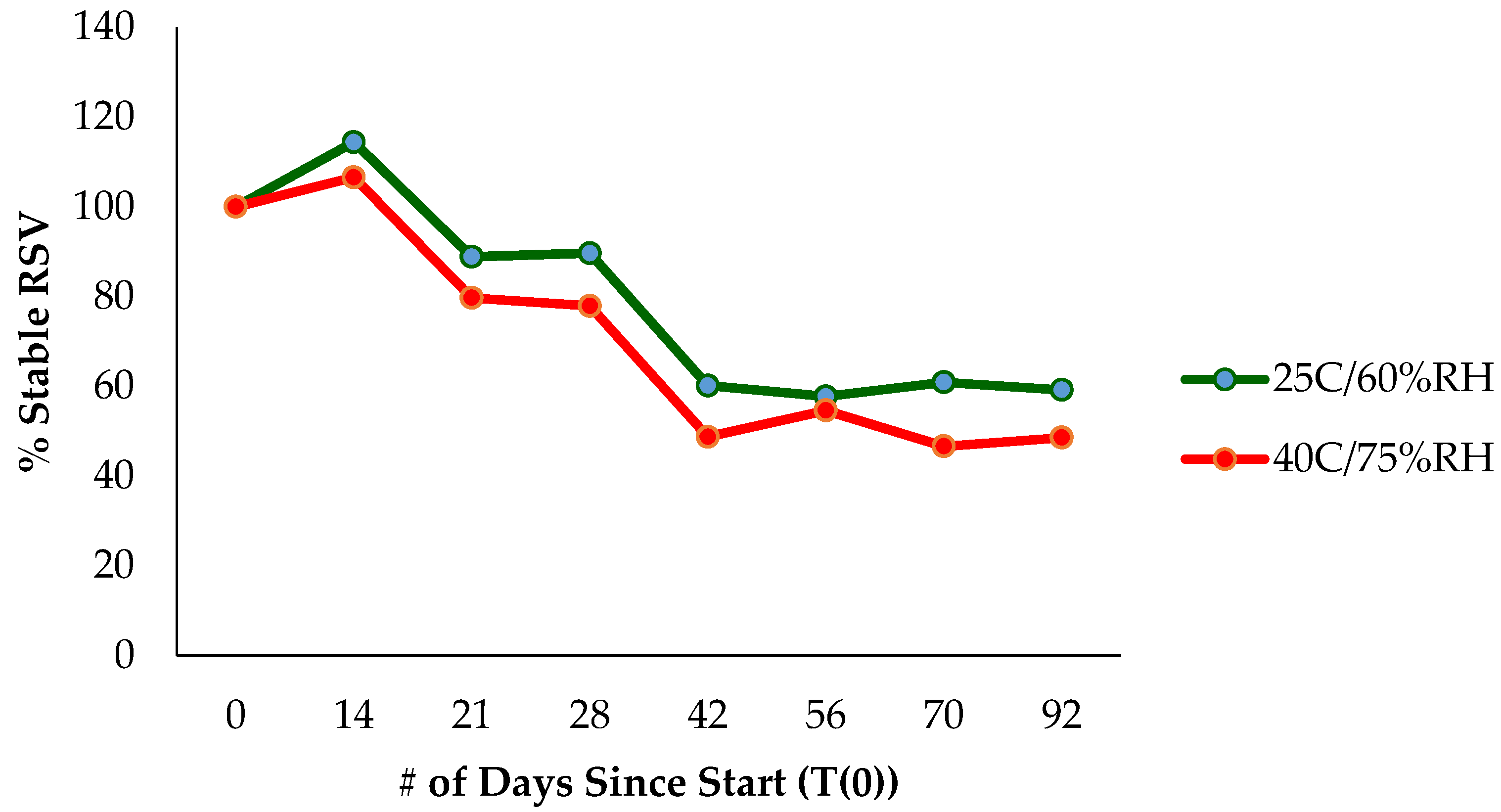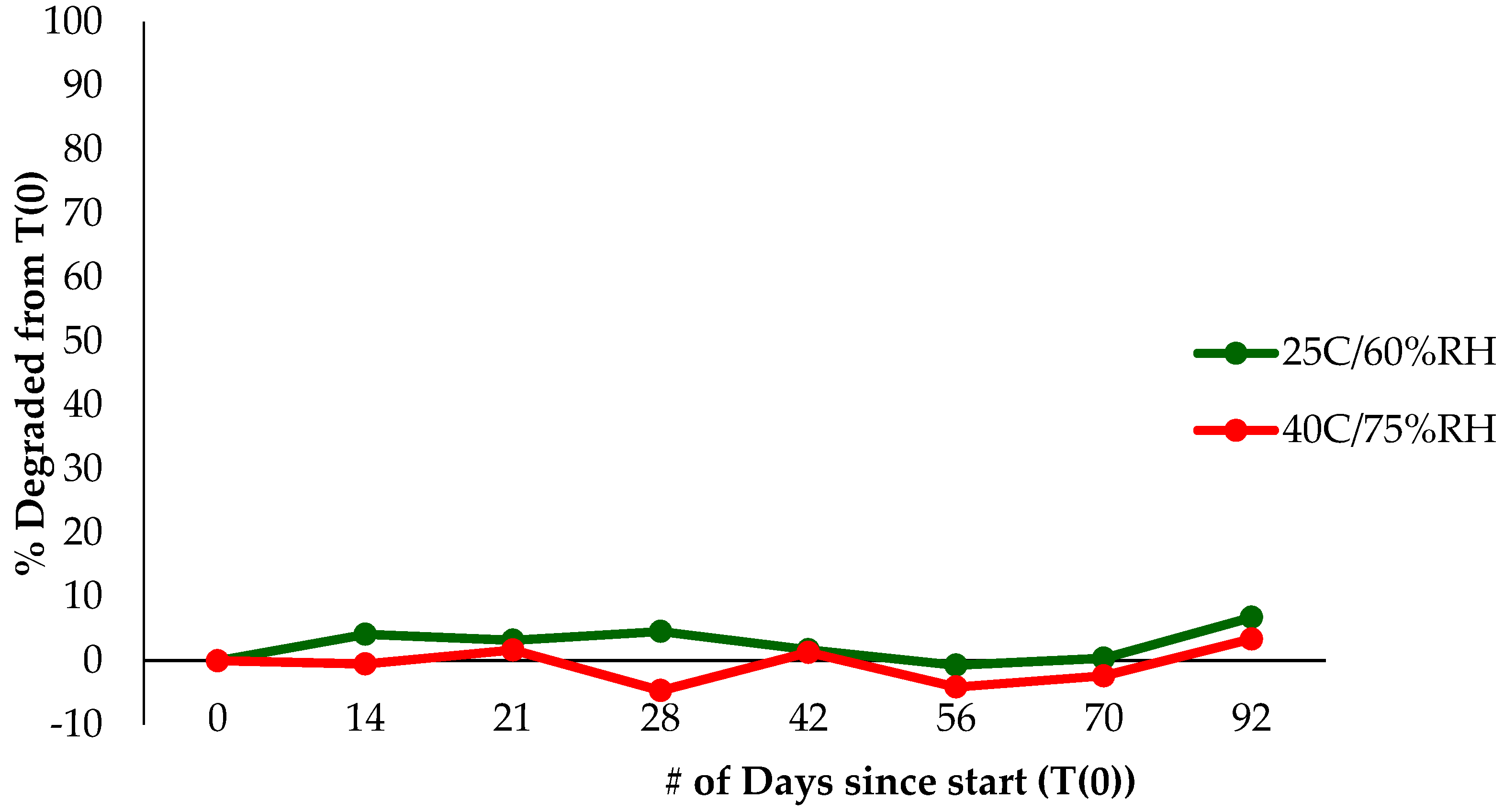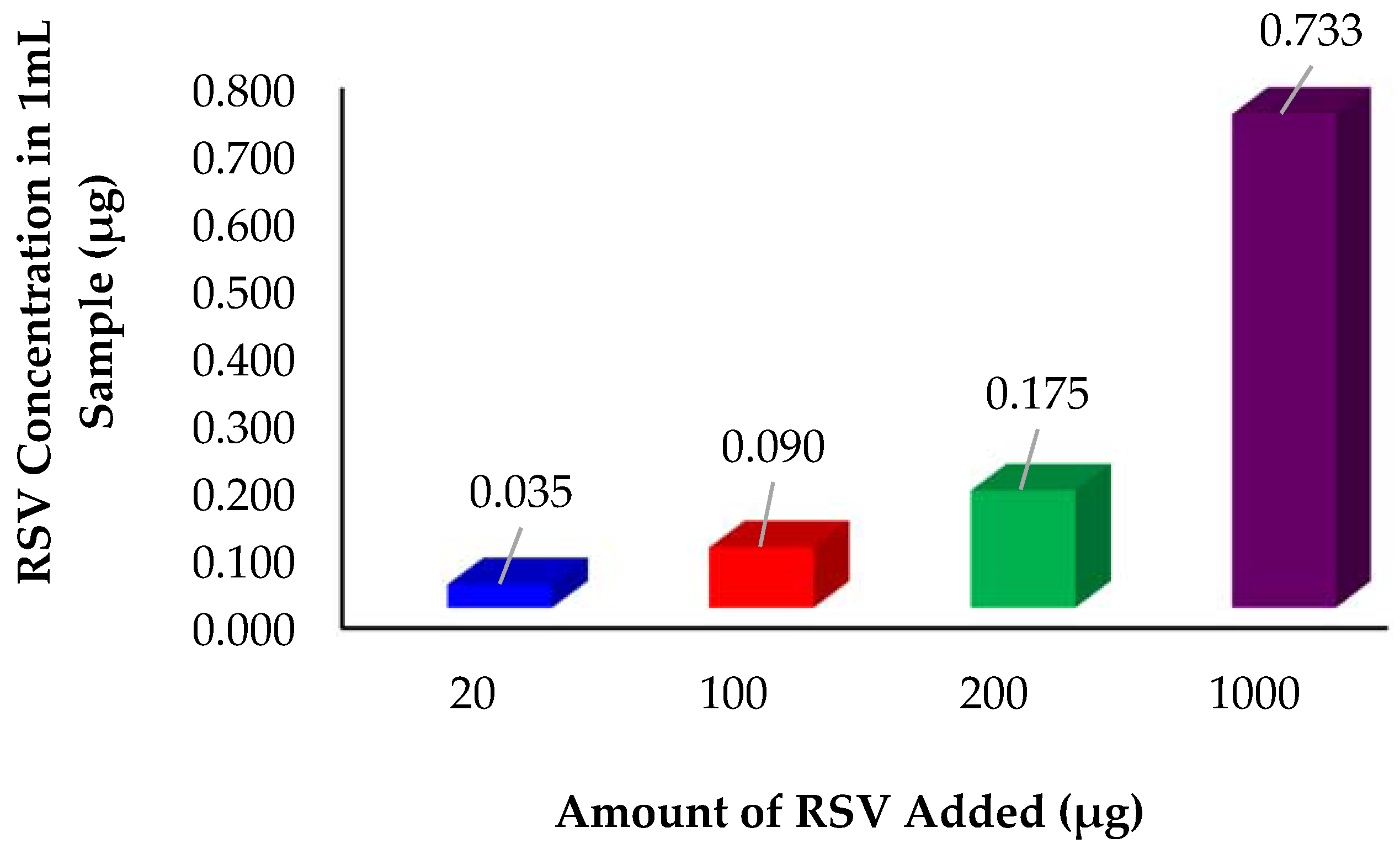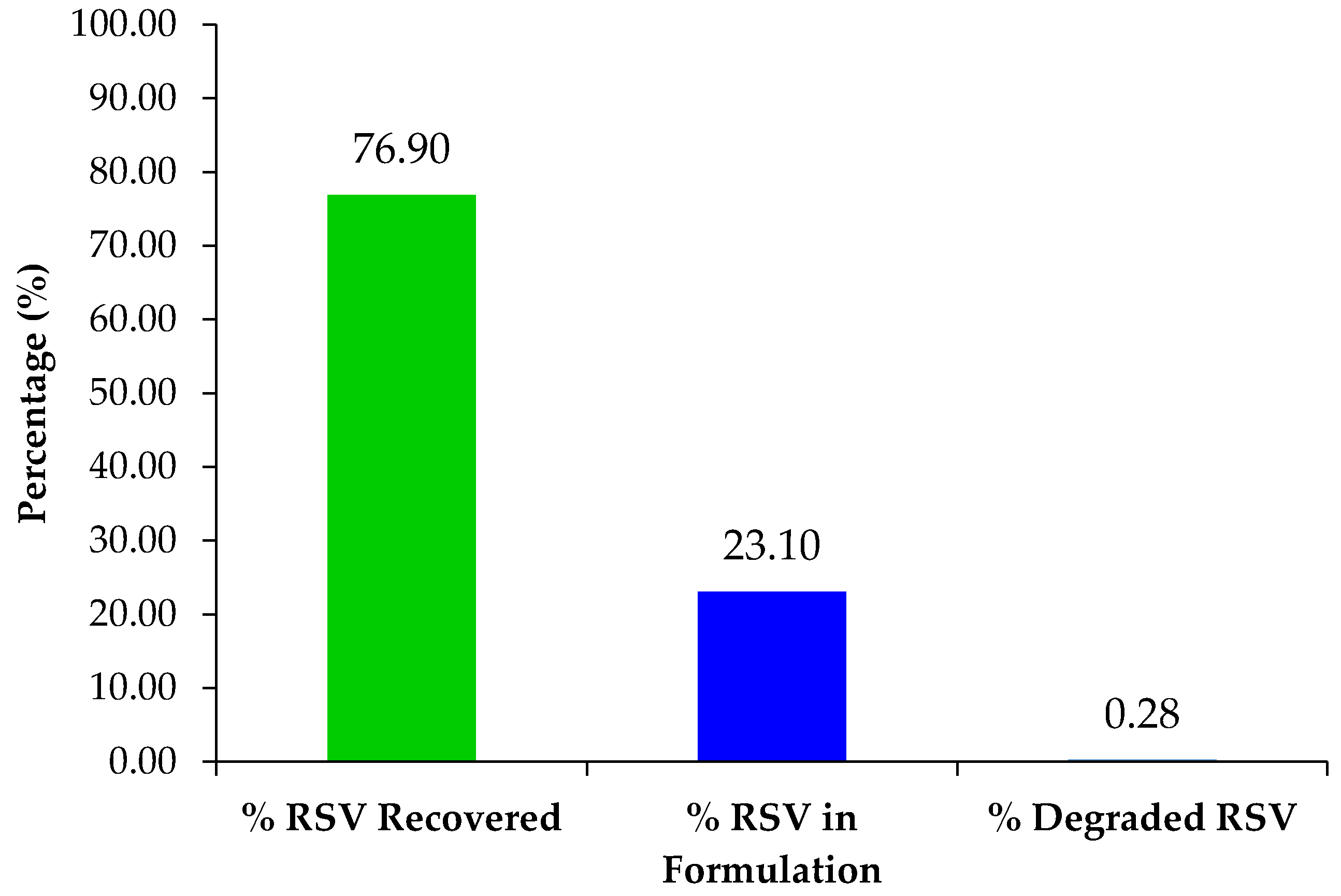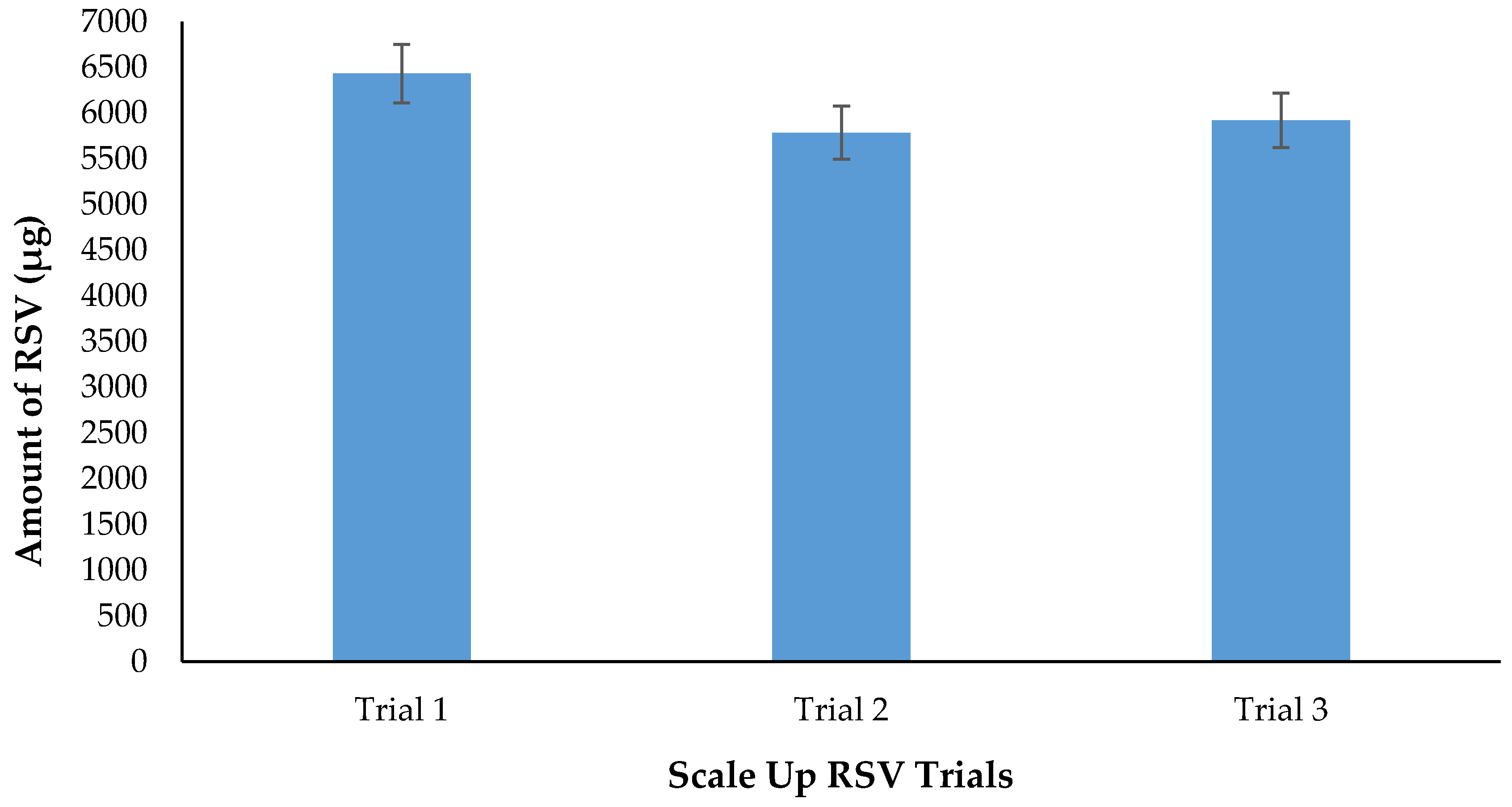1. Introduction
A wide variety of plant food sources, particularly berries, are a source for stilbenes and natural phenolic compounds [
1,
2]. Resveratrol (3,4′,5-trihydroxystilbene, RSV) is one of these stilbene compounds that has two known isoforms—
trans-resveratrol and
cis-resveratrol (
Figure 1)—of which
trans-resveratrol is determined to be the more stable compound of the two [
1,
2]. The isomerization of the
trans-isoform to the
cis isoform is caused by two factors: UV light and high pH. However, the
cis to
trans isomerization is influenced by visible light, high temperatures and low pH [
1,
2]. RSV was first discovered in 1940 in the roots of white hellebore (
Veratrum grandiflorum) [
1,
2]. RSV is commonly found within the skin of red grapes, mulberries, peanuts, pines and
Polygonum cuspidatum weed root extracts [
1,
2]. In these plants RSV acts as an antifungal agent and protects the plant from various infections. Grapes are often infected with
Botryis cinerea, which increases the levels of RSV within the adjacent grapes [
2]. RSV is produced within these plants by fungi, stress, injury, infection or by UV radiation [
3,
4]. Additionally, environmental stress (UV light and heavy metals) have an impact on the overall increased levels of RSV in various plants [
3,
4].
Current uses for RSV include treatment for inhibiting cancer, slowing aging, cardio-vascular disease, antiviral treatments, inflammation, platelet aggregation and other applications [
2,
5]. RSV as an anticancer treatment has been linked with regulatory pathways that have both growth and death attributes [
5]. Additional evidence suggests that RSV helps to maintain genome stability [
5]. Other studies have signified that RSV is a cancer chemopreventative treatment, which has demonstrated the ability to inhibit tumor growth of a wide variety [
5]. One drawback of RSV given orally is that the drug undergoes very rapid metabolism within the body, which overall limits the bioavailability of the molecule at the site of action [
5]. Reports have now suggested that even low doses of RSV that are consumed via the common diet may have a beneficial effect in reducing cardio-vascular disease [
5]. Additional evidence has demonstrated that RSV can increase the potency of a selection of antiviral drugs in the treatment of HIV [
5]. Other studies have indicated that resveratrol can have an anti-inflammatory effect by suppressing tissue factors and cytokines within vasculature cells [
6]. The antioxidant effects of RSV come from the scavenging of intracellular reactive oxygen species (ROS), which maintains the overall concentration within biological systems in the body. Resveratrol studies have indicated that even with oral doses of up to 5 grams of
trans-resveratrol have not shown any major adverse effects in humans [
7].
The use of antioxidants in dietary and skin care products has increased in popularity within the past several years. Aggressive investigations of RSV have been underway for the past twenty years [
1]. Resveratrol is considered to be a very potent antioxidant, which makes it a unique candidate to provide desirable anti-aging effects in cosmetic products. Research has indicated that polyphenols found in wines are some of the most potent antioxidants, which are often several times more potent than vitamins A, C, and E [
1]. Idebenone is considered to be the most potent topical antioxidant, but new studies have indicated that resveratrol has approximately 17-fold higher potency compared to idebenone [
1]. The topical use of resveratrol appears to pose very few risks to consumers while having very large benefits, which allows formulators to target specific formulations to be marketed.
However, resveratrol has limitations as well. One big limitation is that the compound is not water soluble, and therefore, has to be dissolved using other means, such as organic solvents/oils, which are harmful to the environment and the human body. Additionally, resveratrol has stability issues, even in organic solvents. Therefore, increased water solubility and stability of resveratrol are needed for any commercially successful formulation.
Current drug delivery systems, such as polymers and lipids, all have their own restrictions that may include poor reproducibility, water solubility, loading capacity, and stability [
8]. Moreover, often there is a necessity to combine molecules that are hydrophobic and hydrophilic within a single formulation, which can cause incompatibility issues and requires sophisticated solutions. There is a need for a multifunctional delivery system, such as dendrimers, that can solve more than one problem [
9]. The objective of this research was to determine if the use of multifunctional dendrimers can enhance the solubility and stability of
trans-resveratrol to prepare an aqueous topical cream formulation with enhanced RSV concentration. Additional goals included scaling-up any promising dendrimer-RSV formulation for commercial application.
We first reported (no data provided) the role of dendrimers to enhance the solubility and stability of RSV in a conference publication and we have also filed a patent on the proposed work (PCT/US2014/052105) [
10]. In this research paper, we will examine the benefits of using dendrimers to enhance: (i) the solubility; (ii) the stability and (iii) the transdermal penetration of
trans-resveratrol to develop an advanced topical anti-aging cream.
Dendrimers have unique spherical architecture and polyvalency at the nanometer range (
Figure 2). The nanoscale structure of a dendrimer is made up of a main core that is extended out by generation after generation branching process around the central core and ends in polyvalent surface groups [
11]. Dendrimer comes from the Greek word dendron, which means “tree” [
10]. The dendrimer structure demonstrates the capacity to control size of the dendrimer based upon the number of generations, along with the surface functionality provided by using different surface groups. Dendrimer architecture can be tuned to get the desired size and surface to suit a particular drug entrapment problem. This entrapment in the dendrimer allows hydrophobic molecules to dissolve easily in water, and both hydrophobic and hydrophilic molecules can be entrapped together in a single dendrimer structure [
12].
We have demonstrated that dendrimers can be used to enhance the water solubility of different drugs [
10,
11]. We have also shown that drug release can be controlled by physical and chemical modification of the dendrimer structure [
11]. We propose in this work to use PAMAM generation 4 (PAMAM G4) to entrap resveratrol and thus enhance its solubility, stability and transdermal permeation. The resulting dendrimer-resveratrol formulation will be optimized and scaled-up to attain a commercially viable formulation.
3. Materials and Methods
3.1. Materials
The materials used for this formulation include methanol, cyclohexane, water, resveratrol and dendrimers. The methanol came from OmniSolv (Billerica, MA, USA). The cyclohexane was manufactured by Honeywell Burdick & Jackson (Muskegon, MI, USA). The water used was from a Millipore system using a 0.18 μm filter. Generation 4, diaminobutane core, amine surface, poly(amidoamine) (PAMAM) dendrimers were purchased from NanoSynthons (Mount Pleasant, MI, USA) and trans-resveratrol from Sigma-Aldrich (Milwaukee, WI, USA).
3.2. Methodology
3.2.1. Calibration Curve of RSV by HPLC
The calibration graph of RSV was prepared in methanol using HPLC. The standard samples were analyzed via a Dionex UltiMate 3000 HPLC (Thermo Scientific, Waltham, MA, USA) using a Luna C18 column (5 μ 100 A Size: 100 × 4.6 mm, Phenomenex, Torrance, CA, USA). Chromeleon software was used to control the UltiMate 3000 and analyze the data generated. The system flow rate was set to 1.0 mL/min and mobile phase ratio was isocratic throughout the run at a 40% methanol: 60% water for a 20-min run period. The diode array detector of the Ultimate 3000 HPLC was set to a wavelength of 308 nm. Injection volumes for the samples were 25.00 µL per sample.
3.2.2. pH Modification of PAMAM Dendrimer
pH of the PAMAM dendrimer was modified to the physiological pH 7.0 and 2.5 by 1 N HCl.
3.2.3. Dendrimer-Resveratrol Formulation (Solubility Enhancement)
Two different entrapment protocols were developed, namely Protocol 1 and Protocol 2. Control samples were prepared by adding solid RSV in water.
Protocol 1: Entrapment process in water alone.
RSV in excess (2 mg) was added to amber vials containing a total volume of 1 mL, made up of a combination of dendrimer (1 mg, 33.0 µL) and Millipore water (967.0 µL). Each vial was sonicated for 15 s in three 5-s intervals, and then placed in an orbital water bath shaker at 37 °C, protected from light using aluminum foil and shaken overnight. The suspensions were filtered through a 13 mm 0.2 µm nylon syringe filter. One hundred μL of formulation was then diluted with HPLC-grade methanol in an amber HPLC vial and analyzed by HPLC for RSV concentration.
Protocol 2: Entrapment process in water + organic solvent mixture.
RSV in excess (2.0 mg) was added to amber vials containing methanol (500 µL) and vortexed for 15 s. RSV in methanol was then transferred into new amber vials containing dendrimer (1 mg, 33.0 µL) and Millipore water (467 µL). Each vial was sonicated for 15 s in three 5-s intervals and placed in an orbital water bath shaker and shaken at 37 °C, protected from light using aluminum foil for at least 2 h. Upon completion of shaking, the vials underwent lyophilization overnight to remove water and methanol, and were reconstituted with Millipore water (1000 µL). The formulations were placed in an orbital water bath shaker (37 °C), protected from light using aluminum foil and shaken for 2 h. The suspensions were filtered through a 13 mm 0.2 µm nylon syringe filter. One hundred μL of formulation was then diluted with HPLC-grade methanol in amber HPLC vial and analyzed by HPLC for RSV concentration.
On the basis of better RSV solubility enhancement, Protocol 2 was be used for further experimentations.
3.3. Optimization of Dendrimer Amount and Preparation of the Solubility Profile
After establishing methods to entrap RSV in dendrimer, the efficacy of formulation was evaluated by reducing the amount of dendrimer from the original amount of 1.0 mg used to entrap RSV. The purpose was to vary the concentrations of dendrimer, while holding the concentration of added RSV constant. The following dendrimer concentrations were tested using Protocol 2: 0.01, 0.05, 0.1 0.5 and 1 mg/mL. The solubility profile (
Figure 4) was created by plotting dendrimer concentration against RSV concentration in the final formulation.
3.4. Effect of pH on Dendrimer-RSV Complexation
An examination of the effect of pH on the solubility of RSV in the dendrimer formulations was approached in two ways. Two dendrimer solutions (0.1%) were prepared according to Protocol 2. In the first set of formulations, dendrimer solution was first modified to pH 2.5 by 1 N HCl and then RSV was added to prepare dendrimer-RSV complex. In the second set of formulations, dendrimer-resveratrol complex was first formed using pH 7.0 dendrimer (
Section 3.3, Protocol 2), and then pH of this final formulation was lowered pH 2.5. Additionally, a control formulation of RSV in pH 2.5 water was prepared.
3.5. Dissolution Studies
An examination was made regarding dissolution of RSV in simulated gastric and intestinal environments. Simulated gastric and intestinal fluids were prepared, with the simulated gastric fluid consisting of HCl, NaCl, Pepsin, and water while the simulated intestinal fluid consisted of NaOH, KH2PO4, and water. 1 mL of a 0.1% dendrimer-resveratrol formulation was prepared using Protocol 2 and analyzed via HPLC. The formulation was split into two equal aliquots and lyophilized. Ten mL of the simulated solutions were added to the respective lyophilized dendrimer-resveratrol formulation, and the fluids were stirred at a low speed (1 on an arbitrary 10-point scale stir plate). This experiment was protected from light. At various time points, 0.5 mL aliquots of fluid were removed from the chambers and analyzed via HPLC. The volume removed was replenished with fresh simulated fluid. Control formulations of resveratrol alone, were analyzed simultaneously and compared to the dendrimer-containing formulations.
3.6. Transdermal Permeation Study
Transdermal permeation studies were conducted using Franz Diffusion Cells (FDC) and rat skin samples. The diffusion cells had a 5 mL receptor chamber and were manufactured by Permegear (Hellertown, PA, USA). The formulations examined were a 0.1% dendrimer-resveratrol formulation, and a control of free resveratrol in water. For each formulation, the receptor chamber of the FDC was filled with 5 mL of a PBS (pH 7.4):methanol 90:10 mixture. Skin samples from Dahl Salt Sensitive rats were cut to size and placed at the interface of the donor and receptor chambers. 0.5 mL of the desired formulation was placed in the donor chamber and the FDC was stirred on a stir plate set to 6 (on an arbitrary 10-point scale). At various intervals over a 24-h period, 400 μL was removed from the receptor chamber by means of the sampling arm and analyzed by HPLC. The volume was replaced by an equal amount of fresh PBS: methanol mixture. After 24 h, an aliquot was taken from the donor chamber and the skin was removed and RSV recovered by soaking skin in 2 mL methanol and sonicating for 10 min followed by filtration and HPLC analysis as discussed before.
3.7. Stability Study of Resveratrol, Resveratrol + Tween 80 and Resveratrol + Dendrimer in Aqueous Solution
Purpose of the stability testing of RSV in solution was to determine how long RSV is stable in aqueous solution to predict its shelf life expectations. RSV formulations with dendrimer and Tween-80 were prepared along with a control in methanol. Samples were stored at Wisconsin Pharmacal Company (WPC, Jackson, WI, USA) under ICH Q1A conditions in the following temperatures: 4 °C/0% RH, 25 °C ± 2 °C/60% ± 5% RH, 40 °C ± 2 °C/75% ± 5% RH. The samples were collected on the following time points: Day 0, 1, 3, 7, 10, 14, 21, 1 month, and 2 months. The collected samples were measured for RSV content by HPLC. A graph was plotted between percent remaining RSV against time for each temperature point to evaluate stability of the formulations.
3.8. Resveratrol + Dendrimer in Cream Dosage Form
3.8.1. Method Development for Extraction of RSV from Cream Formulations (RSV Cream Extraction Method)
The purpose was to develop a method to extract RSV from the cream formulations in order to analyze the RSV content. RSV (1 mg) was dissolved in methanol (1 mL). This RSV solution was then mixed with cream (0.5 g, provided by WPC) in a 30 mL amber glass vial and properly mixed to prepare a homogeneous formulation. Next, methanol (9 mL) was added to the cream which was vortexed. Cream was warmed in a water bath at 37 °C for 5 min and placed in an ice bath for 15 min. The cream mixture was subjected to the gravity filtration (W&R Balston Filter Paper No. 3, 15 cm) into a 15 mL plastic conical vial. The filtered solution was centrifuged at 4000 rpm in a 5810 centrifuge (Eppendorf, Hauppauge, NY, USA) for 15 min. After the sample was centrifuged, the supernatant was decanted into a 125 mL separatory funnel. The methanol based mixture was treated with cyclohexane (7 mL). Six cyclohexane extractions were performed. After all the extraction steps, the collected methanol fractions were combined and filtered using a 13 mm 0.2 μm syringe filter into a new 30 mL amber glass vial. The sample underwent HPLC analysis.
3.8.2. Stability Study of Resveratrol + Dendrimer in Cream Formulation
Purpose for this experiment was to test the stability of the resveratrol-dendrimer complex in finished cream formulation by conducting a 3-month stability study. Dendrimer-RSV formulation was mixed using a drill mixer at slow rpms to ensure even distribution of the formulation. Using a 20 mL syringe, cream (1 g, provided by WPC)) was added to each product container and the plunger within the tube was pushed up to remove excess air. Formulations were placed under ICH Q1A conditions of: 25 °C ± 2 °C/60% ± 5% RH, 40 °C ± 2 °C/75% ± 5% RH. Samples were collected at the following intervals: Day 0, 1, 2, 3, 4, 6 and 8 weeks. Stability graph was plotted between % remaining RSV against time for each temperature point.
3.8.3. Extraction of Resveratrol from Commercially Available Resveratrol Products
The purpose for conducting this experiment was to test commercial RSV products to see if the claimed amount of resveratrol was present in the products. Each product (0.5 g) was subjected to the developed cream extraction protocol and the RSV content estimated.
3.9. Formulation Optimization and Scale-Up of Resveratrol + Dendrimer Formulation
3.9.1. Reduction of Excess RSV Added to Initial Stock Formulation
The purpose was to reduce amount of RSV added to the initial formulation to reduce overall formulation costs. The remaining steps were followed according to Protocol 2.
3.9.2. Reduction of Reconstitution Water Volume Post Lyophilization
The purpose was to reduce the reconstitution volume required to prepare concentrate dendrimer-resveratrol formulation. Reconstitution volume was reduced from 1 mL to 0.15, 0.5 and 0.1 mL. The remaining steps were followed according to Protocol 2.
3.9.3. Extraction of Excess Resveratrol from Syringe Filters for Reuse
The overall purpose of this experiment was to extract the remaining uncomplexed RSV from the syringe filters to illustrate that the excess RSV could be recovered and reused in further studies if necessary. The syringe filter(s) were placed into a 250 mL media bottle and soaked in approximately 100 mL of fresh methanol. The filters were swirled well and analyzed by HPLC.
3.10. Formulation Scale-Up
The purpose for this experiment was to scale up the RSV+ dendrimer formulation from 1 mL to 100 mL formulation. Also we aimed to increase the RSV concentration from 1 μg/mL to 10 μg/mL. First RSV (100 mg) was added to a 500 mL media bottle followed by the addition of fresh methanol (50 mL) and stirred well. Next, in a separate 500 mL media bottle, dendrimer (4.18 mL, 5 mg or 0.005% w/v) was added along with Millipore (Billerica, MA, USA) H2O (45.82 mL) and mixed well. The two solutions were mixed together in the media bottle containing the RSV. The solution was then sonicated for 5 min at sixty 5 s intervals. After sonication, the media bottle was covered with aluminum foil and placed in a 37 °C orbital shaker for 2 h. Upon completion of stirring, the solution was then lyophilized overnight. Post-lyophilization, the formulation was reconstituted using Millipore H2O (100 mL) and mixed well. The formulation was then sonicated for 5 min in 60 5 s intervals. After sonication, the formulation was placed into the 37 °C orbital shaker for 2 h. Then the formulation was removed from the shaker and filtered using a 13 mm 0.2 μm nylon syringe filter into a fresh 500 mL media bottle. The filtered solution was then analyzed by HPLC.
